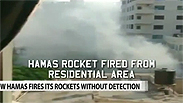
Foreign journalists reveal Hamas' false front
The world didn't believe Israel, but it might believe foreign reporters who were afraid to offer real-time reports but now tell all: A Hamas HQ at Al-Shifa Hospital, launchers near UN facilities, and staged bomb scenes.
It has been said that when the cannons are heard, the muses are silent. In the case of foreign reporters in the Gaza Strip, their silence stemmed mostly from fear.
A day after Operation Protective Edge ended, a truer picture slowly began emerging: foreign reporters leaving the Gaza Strip revealed what Israel has claimed all along – that Hamas had fired out of population hubs and near UN facilities.
Related stories:
- 'Smashing a peanut with a hammer': Foreign journalists on int'l coverage of Gaza fighting
- VIDEO: Finnish reporter sees rockets fired from Gaza hospital
- No room for al-Jazeera broadcasts in Israel, says minister
Why didn't they report those facts during the ongoing fighting? According to the reporters, they feared for their lives. "We saw the Hamas men," a Spanish reporter admitted. "But had we dared point the cameras at them, they would have opened fire at us and killed us."
Now that they're out of the Gaza Strip, the reporters are revealing what Hamas tried to prevent the world from seeing. An Indian reporter, for example, documented how Hamas militants launched rockets from a post right outside the window of the hotel where he was staying in the Gaza Strip, shortly before the ceasefire came into effect. The video aired only after the reporter left Gaza. When asked about it, he replied: "There's a conspiracy of silence rooted in fear – no one wants to report in real-time".
The report by Indian journalist Sreenivasan Jain for Hindi language news channel NDTV went as follows: "It began with a mysterious tent with a blue canopy that bobbed up yesterday (August 4) at 6:30 am in an open patch of land next to our window. We saw three men making a multitude of journeys in and out of the tent, sometimes with wires.
"An hour later, they emerged, dismantled the tent, changed their clothes and walked away."
The journalist stressed that it is "important to report on how Hamas places those very civilians at risk by firing rockets deep from the heart of civilian zones."
FRANCE 24 correspondent Gallagher Fenwick aired a report showing rockets being launched just 50 meters away from the hotel where foreign journalists were staying and 100 meters away from a UN facility.
Italian journalist Gabriele Barbati also told the truth about Hamas once he left the Strip, no longer under their threat. In a tweet, Barbati said: “Out of #Gaza far from #Hamasretaliation: misfired rocket killed children yday (yesterday) in Shati. Witness: militants rushed and cleared debris.” He added: “@IDFSpokesperson said truth in communique released yesterday about Shati camp massacre. It was not #Israel behind it.”
Another foreign reporter said that it is an open secret that Hamas uses Al-Shifa hospital as its command center, but that reporters in Gaza would not report that out of fear that it would endanger them.
However, not only foreign reporters were afraid of Hamas' potential revenge. Palestinian reporters also suffered threats when they attempted to criticize the terrorist organization and give truthful reports.
Local Palestinian reporter Radjaa Abu Dagga, for example, reported that he was summoned for questioning at Al-Shifa hospital, where armed Hamas militants attempted to determine whether he writes for an Israeli newspaper. Abu Dagga said that his passport was taken from him, and he was prohibited from leaving the Gaza Strip. Later he published an article in French newspaper Libération, but was forced to remove it after receiving threats.
Reporters in Gaza were subject not only to threats but also to Hamas' manipulations. The Washington Post's Sudarsan Raghavan detailed how the organization's men staged the IDF attack scenes: he said that he was taken to photograph a mosque that had been bombed, and discovered that someone had "prepared" the scene and placed a prayer mat and burnt Quran pages.
He later reported that it was obvious that someone had put them there to create empathy for the Palestinian struggle.
The CBN news website said that apart from mosques, Hamas is also using church compounds to launch attacks. In his report, journalist George Thomas said that Gaza's most prominent Christian leader, Archbishop Alexios, "took CBN News to the roof terrace outside his office to show how Islamists used the church compound to launch rockets into Israel."
The Archbishop explained that "Islam is the rule of this place and whatever Hamas says we must obey or face consequences," Thomas added.
A foreign reporter's testimony: Hamas' manipulations
Yedioth Ahronoth exclusive
Hamas' control of the foreign journalists' coverage during the days of fighting in Gaza was not very sophisticated, but very effective.
First, Hamas determined that the organization's spokesmen could be interviewed only in the the courtyard of Al-Shifa hospital. As a result, long lines of reporters waiting for an interview were created, and during their wait, they witnessed wounded people who arrived to receive treatment. This created the impression Hamas was seeking to convey: a state of immediate emergency and humanitarian disaster.
Secondly, Hamas has never allowed foreign reporters access to military sites attacked by Israel, whether they are bases, rocket-launching sites or other Hamas targets. The dead and wounded of the organization were not captured on film as well, and hence from a media perspective they didn't even exist. All this served Hamas' purpose in creating an impression that all the victims were civilians.
Thirdly, it was clear that Hamas was launching rockets out of populated civilian areas, but the organization demanded that the press photographers not document the launch sites, so as to not expose their tactic, nor disclose the location of the launchers
The reporter requested that his name not be used.











